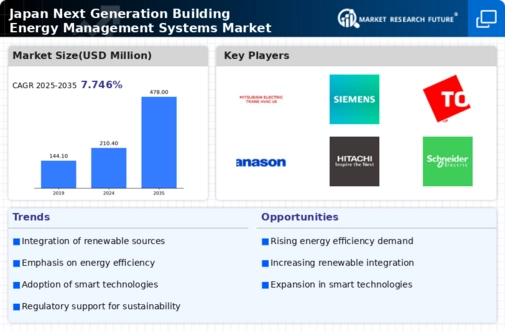Rising Energy Costs
The escalating costs of energy in Japan are driving the next generation-building-energy-management-systems market. As energy prices continue to rise, businesses and consumers are increasingly seeking solutions to optimize energy consumption and reduce expenses. The implementation of advanced energy management systems can lead to significant savings, potentially reducing energy costs by up to 30%. This financial incentive encourages the adoption of innovative technologies that enhance energy efficiency. Furthermore, the Japanese government has been promoting energy conservation initiatives, which align with the objectives of the next generation-building-energy-management-systems market. As a result, organizations are more inclined to invest in these systems to mitigate the impact of rising energy prices.
Growing Environmental Awareness
There is a notable increase in environmental awareness among consumers and businesses in Japan, which is influencing the next generation-building-energy-management-systems market. As sustainability becomes a priority, organizations are seeking solutions that minimize their carbon footprint and promote eco-friendly practices. The next generation-building-energy-management-systems market offers tools that facilitate energy conservation and reduce greenhouse gas emissions. According to recent studies, companies that adopt energy-efficient systems can decrease their carbon emissions by as much as 25%. This growing emphasis on sustainability is likely to drive the adoption of advanced energy management systems, as organizations strive to meet both regulatory requirements and consumer expectations.
Integration of Smart Building Technologies
The integration of smart building technologies is emerging as a key driver for the next generation-building-energy-management-systems market. As buildings become increasingly automated, the demand for sophisticated energy management systems that can seamlessly integrate with smart technologies is rising. In Japan, the market for smart building solutions is projected to grow at a CAGR of 15% over the next five years. This trend indicates a strong inclination towards adopting systems that enhance operational efficiency and energy performance. The next generation-building-energy-management-systems market is well-positioned to benefit from this integration, as organizations seek to leverage smart technologies to optimize energy consumption and improve overall building performance.
Government Incentives for Energy Efficiency
The Japanese government has introduced various incentives aimed at promoting energy efficiency, which significantly impacts the next generation-building-energy-management-systems market. These incentives include tax breaks, subsidies, and grants for businesses that invest in energy-efficient technologies. For instance, the government has allocated approximately ¥100 billion to support energy-saving initiatives in commercial buildings. Such financial support not only reduces the initial investment burden but also encourages the adoption of advanced energy management systems. Consequently, organizations are more likely to implement these systems to comply with government regulations and benefit from available financial incentives, thereby driving market growth.
Technological Advancements in Energy Management
Technological advancements are playing a crucial role in shaping the next generation-building-energy-management-systems market. Innovations such as artificial intelligence, machine learning, and big data analytics are enhancing the capabilities of energy management systems. These technologies enable real-time monitoring and predictive analytics, allowing organizations to optimize energy usage more effectively. In Japan, the integration of these advanced technologies is expected to increase the efficiency of energy management systems by up to 40%. As businesses recognize the potential benefits of these innovations, the demand for next generation-building-energy-management-systems is likely to surge, further propelling market growth.



















Leave a Comment